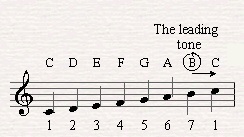G major Scale and D major Scale - What's Their Leading Tone?
Home » Piano Theory » D Major Scale

As you can see both G major scale and D major scale follow the formula of:
W W h, W W W h
And this is how we formed these scales. Let's take D major for example.
Our starting note is D of course!
From D we take a whole step to E.
From E we take a whole step to F# (Notice that that a whole step from E takes us to F# not F.
Next we go a half step to G.
From G a whole step will take us to A.
Next is another whole step to B.
The last whole step take us to C#.
Finally the half step returns to D.
Notice that D major has two sharps and that G major scale has one sharp.
The Leading Tone

Inside the scale forces are pushing toward specific notes. The most common of them is the seventh note (B in C major) which is clearly aiming toward C. That's why it is called the leading note. It demands us to go us back home like a musical magnet.
Question:
What is the leading tone in G major scale and D major?
Later on when we will speak about Chords we will remember the effect of the leading tone in order to understand the function of chords in a musical scale.
Return from G major Scale and D major Scale - What's Their Leading Tone? to Piano Theory














